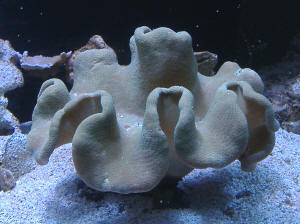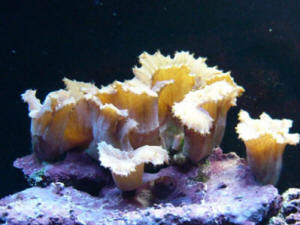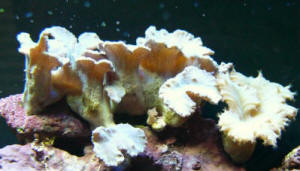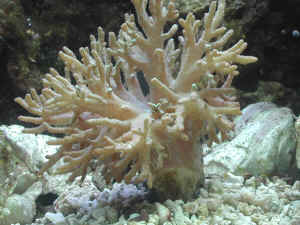|
FAQs about Pathogenic
(Infectious,
parasitic),
Disease of Soft Corals of the
Family Alcyoniidae
FAQs on Alcyoniid Disease:
Alcyoniid Health 1,
Alcyoniid Disease 2,
Alcyoniid Disease 3,
Alcyoniid Disease 4,
Alcyoniid
Disease 5, Alcyoniid
Disease 6, Alcyoniid
Disease 7, Alcyoniid
Disease 8, Alcyoniid
Disease 9, Alcyoniid Health 10,
Alcyoniid Disease 11, Alcyoniid
Health 12, Alcyoniid Disease 13,
Alcyoniid Disease
14, Alcyoniid
Disease 15,
FAQs on Alcyoniid Disease by Category:
Diagnosis,
Environment,
Nutritional,
Predator/Pests,
Social, Trauma,
Treatments
Related Articles: Soft Corals of the Family
Alcyoniidae
Related FAQs: Soft Corals of the Family Alcyoniidae,
Alcyoniids 2, Alcyoniids 3, Alcyoniids 4, Alcyoniid ID, Alcyoniid Selection, Alcyoniid Compatibility, Alcyoniid Systems, Alcyoniid Behavior, Alcyoniid Feeding, Alcyoniid Propagation, Soft Coral Propagation, Soft Coral Health, Dyed Corals, Soft Coral Propagation, Nephtheids, Dendronephthya, Paralcyoniids, Nidaliids, Xeniids, Dyed
Corals,
|
|
Toadstool necrosis and healthful timing
3/21/07 Hi GrahamT, <Hello, Daniel.> I am sorry for the
misspellings and other errors in the previous e-mail. <I
understand the constraints on your time, and thank you for your
consideration. I will do my best to reciprocate.> I have a
question about my toadstool that I have in my 135 gallon Reef tank.
I bought it about 3 weeks ago at a LFS. It fully extends during the
day with all polyps out. <Excellent.> But at the base of the
coral it seems to be deteriorating or going necrotic. <Ahh...I
see.> I have read through the website and found some helpful
ideas. My question is when I cut the head of the coral off and toss
the stem out have I already infected the rest of the tank even
though I have no other leathers? <Hmm, *I* can't answer that
directly. I am not sure about the pathogen, if any. I will tell you
that this is usually a chain-reaction on the cellular level, where
contact is a requisite 90% of the time; meaning that if you cut off
the affected part well into the "good" tissue, you can
curb its spread.> Where does this infection usually come from
miss handling in transit? <It can start from a physical trauma,
or injury. Sometimes, it seems as though the specimen has had it
with its location and oozes away.> Will coral dipping help to
control the infection? <Doubtful. It *may* have done something
useful previous to this condition, but probably not. I would say
that the possible benefits don't outweigh the risk of extra
stress at this point.> The tank parameters are:
Salinity: 1.025
Nitrate: 0 ppm
Nitrite: 0 ppm
Ammonia: 0ppm
Calcium: 450
ppm Temperature: 81
degrees F <All good...> The inhabitants are:
160 pounds of live
Caribbean rock 120
pounds of live aragonite sand
Fairy Wrasse
2" Carpenter
Wrasse 2" Blue
bar Pseudochromis 2"
Blue Devil Damsel
1" South Seas
Devil 1" 2x
Blood Shrimp 2"
Assortment of
snails and hermits. Equipment is:
2x Mags 9.5
2x Aqua clear
701's power heads
Dual 400W Double
ended 14k MH
SeaClone 150
protein skimmer <Do you like this skimmer?> Water changes are
done once a week at 10% Here is a pic of it the first day I brought
it home. http://i101.photobucket.com/albums/m46/blackhemi35003/DSCF0443.jpg
<Looks normal there. I think that all in all, you've got the
right idea. I want to thank you again for taking the time to repost
your query, and for taking the initiative to help your charge(s) by
researching. (It makes me feel... well, vindicated) Daniel
Carrel
<GrahamT> |
|

|
| Sick Cabbage Leather With Fungus at Base? 7/5/05
Dear Crew, <Sorry for the lateness of
this reply... misplaced> Thanks for
taking the time to answer my question. I have searched the
FAQ's over and over but cannot find the answer I am looking
for, so here I am. Here goes: I have a sick
looking batch of cabbage leather. They don't appear very well
today. Found this fungus area with some dark brown on it about 5
days ago. I think this may have started when I upgraded the lights
from 83watts Power Compact Fluorescent to 143watts PC. The coral is
in the top third of the tank near the lights. <Mmm, I might
(have) moved this colony lower...> It was doing great with the
new lights and it's polyp extension was incredible. Sorry I
don't have a pic of it with the new lights and happy.
Here's a pic 3 months ago with
83wattsPC: <Very nice>
You can see the base where the leather is
shedding as it grows. <Yes, natural>
Here is a pic today, with 143watts PC:
<Yikes, a bit "burnt"> The
piece on the far right is on a separate stalk from the other; which
is all one bunch. Close-up of the tissue
damage: <Unfortunately pic didn't come through>
Could this be caused by the new lights?
<Yes... but this is likely only a co-factor... something like
other livestock incompatibility is likely at play here.>
Is there anything I can do to save it?
<At this juncture, mainly time going by... addition of
Lugol's, other iodine/ide might help, be worthwhile> How
about a soft toothbrush scrubbing in a bowl of tank water and then
move down on the bottom? <Mmm, I would not do this>
All other corals and fish are beautiful and
smiling. The nearest coral is a frogspawn whose head is 6" -
7" away. Thanks, David <A water
change, adding some activated carbon in your filter flow path would
be good as well. Bob Fenner> |
|
 
|
| Re: Sick Cabbage Leather With Fungus at Base? ***UPDATED***
7/5/05 Dear Crew, <David>
Here is an update which may or may not
help. I vacuumed off the supposed tissue damage. It's now
clean. It was from the coral shrinking and shedding. The stalks are
clean, but the coral still looks real bad. I did turn off the
65watt PC Actinic03 just in case. He looks stressed.
System Specs: 29gal Bare Bottom, 42#'s
Live Rock, skimmer working good. Currently fighting Cyanobacteria
problem by all recommended means without the dosing of chemicals.
The only thing that has been added was a 2" x 4" piece of
Poly Filter to my HOB filter. Sometimes I use this HOB filter,
which is stripped clean, to run carbon. Mostly LPS: hammer,
frogspawn, very large open brain, Zoanthids, Palythoa, Diploastrea
Heliopora, cabbage leathers, and mushrooms. <The Zoanthids,
Corallimorphs are pretty toxic tankmates... w/o substrate to
complex...> 2 clowns, a 2 year old blue dragonet (loves frozen
foods), 2 peppermint shrimp, 3 porcelain crabs, 6 Astreas. Water
param.s as of 20 min.s ago: Temp - 82ºF SG - 1.0265
(refractometer) dKH - 8 CA - 370ppm pH - 8.4 Nitrates - 0 Nitrites
- 0 Phosphate - 0 Ammonia - 0 (just for the heck of it) <All
look good> It has been a week since I dosed with 2 part B-Ionic
alk/CA buffer. So I know my CA and dKH are low. Usually dose twice
a week, but with the Cyano problems I have been doing 10% water
change with aerated and heated water every 3 days. Using Instant
Ocean salt, BTW. HTH, Thanks again, David <Do please take a read
through our Cnidarian section: http://www.wetwebmedia.com/marine/inverts/index.htm
I suspect a good deal of your problems are due to the mix of
species you are housing together. Bob Fenner> |
| Green Finger problem (?) Hey
Gang, how you doin'? well I hope. <very fine with thanks>
I finally got some clear pics. of a green finger
coral in hopes that someone might be able to diagnose
the base of this beauty, I don't have any experience on what
the appropriate course of action should be. <a very common
problem with "colored" leather corals. They are very
sensitive to handling. Please avoid touching them with a bare hand
at all times. Handle only the base or tissue with gloved hands
otherwise> Its been in my tank for three days, and the base
looks worse by the day. <it is highly infectious although looks
mild here so far> It looked nice at the store (a little frayed
at the base) though I probably shouldn't have
purchased, but, I reckon hind sight don't apply
here. Thanks for the Your friend in Denver, Scott <simple
solution here. Have a VERY sharp razor blade or scalpel ready. A
needle with clean nylon thread (or fishing line) ready and waiting
to stitch too. A piece of small rock or rubble as well. Move
3/4-1" above the highest necrotic area of the base of the
stalk. Cut clean and fast through the animal. You must wear gloves
and keep the procedure down to a minimum time of handling. After
the cut, look at the exposed trunk and be sure that you cleared the
soft and necrotic area... if so, run a stitch or two through the
base (no more than an inch from the bottom) and tie it off to a
piece of rock. Return it to the exact same place it was in the tank
and do not touch it for weeks. Maintain strong water flow and very
aggressive skimming in the tank. Small daily doses of iodine may be
therapeutic for the tank too (not extra iodine... just your weekly
dose broken down to daily). Best regards,
Anthony> |
 |
 |
| Re: Green Finger problem (?)
Thanks for the info, it will be easier for me to perform this,
"MASH 4077" style surgery, out of the water. Will these
be ok? <yep... it all takes mere seconds> Just one clean cut,
eh. <correct> Is the corals tissue tough to cut thru, like
muscle? or, will it be like a hot knife thru butter? <rather in
between... the tissue is quite soft but infused with calcareous
spicules> (just paged my head nurse to the emergency room,
stat!) Wish me luck, we're goin' ............Thanks,
Scott <Banzai! Or is it bonsai? Both I suppose. Best
of luck! Anthony> |
Leather Coral infection Anthony, Working late nights again I
see. <yes... back from a trip and feeling guilty at having
left our friend Steve high and dry solely with e-mail duty
<smile>> Thanks for the advice. I will try cutting in place
and supplementing with iodine as you recommended.
<excellent... it really is a simple and safe maneuver> Running
some AC for a few days after the cut would probably be helpful
too? <absolutely...although there is a minor concern of light
shock to improved water clarity (yellowing agents) if carbon has not
been used for a while (4+ weeks... a bad habit)> Just curious, but
do you have a guess as to what caused this damage, (bad water quality,
fish/crab nibbling,...)? <so many things it could be..
although water quality and aggression from another coral (even if not
touching... called allelopathy. Commonly from hostile LPS corals like
Galaxy, Hammers, bubbles and the like)> Also, thanks for the plug on
your book. <no... thank you for tolerating the shameless
nature of it <wink>> When my wife and I were looking to buy a
good coral book, your book and Borneman's was recommended. We went
with the one with the pretty pics. We're suckers for nice color
reef photos. :-) <understood and agreed... as I am too
<G>> But you can never have too many books, and now that
we've satisfied our pics Jones, we'll be looking to get your
book as well. Thanks! <thank you... best regards, Anthony>
Leather Coral infection WWM Crew, How's everyone
doing? <very well... thank you, with hope that you are the
same> I have a question regarding my leather toadstool coral. A few
days ago, I found a damaged area at the bottom edge of his crown. At
first it looked like something took a little triangular cut out of it.
That cut has grown larger since, and the tissue is very dark around
that area. The rest of the coral looks fine, with polyps still fully
extending. I've included pics of the top and the infected area on
the bottom (sorry about the quality). <the coral is in overall
excellent health> I read in Borneman's book that these corals
are fast healers and cutting the infected area off, accompanied by a
short FW dip would effect a cure. I just wanted a second opinion.
< I concur and have written rather extensively about
propagating/cutting this species in my book as well
(http://www.wetwebmedia.com/bkcorlproprev.htm)> The coral is firmly
attached to 2 largish pieces of LR, and removing the whole thing for
the "surgery" would be a lot of work. I just wanted to know
if I should leave it be and hope for it to get better, or if cutting
away the infected area is the best thing to do. Thanks in advance.
<cutting would definitely be best and recommended. Wave the polyps
down (fully retracted) and go in with a very sharp pair of scissors and
cut a notch out of the crown 1/2 to 1 inch beyond the dark necrotic
area. With reasonably good current and protein skimming in the tank...
you may not have to remove the animal for dipping. Normal daily iodine
doses for the tank in general can be therapeutic as well. Best regards,
Anthony>
|
|

